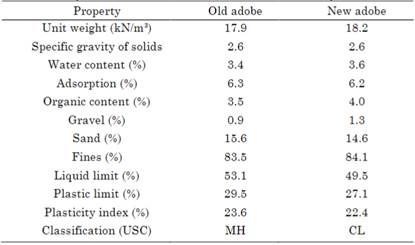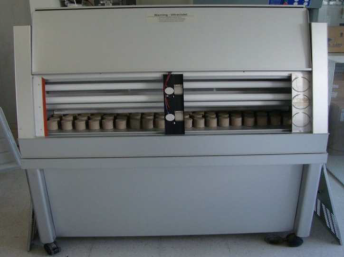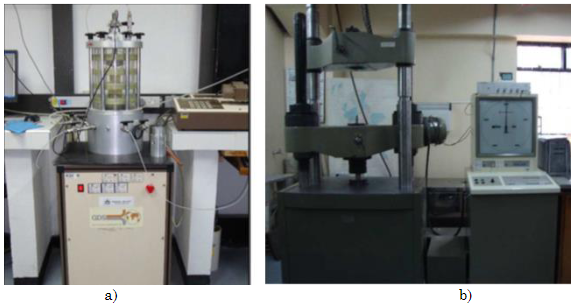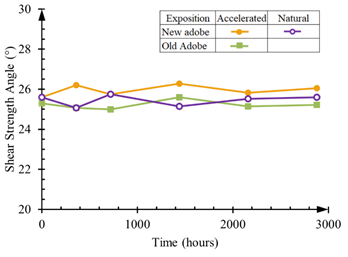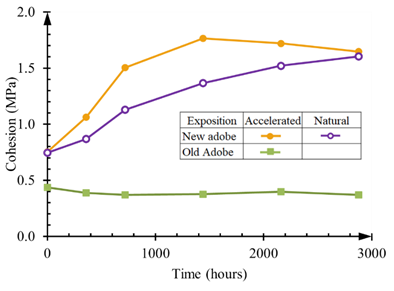1. INTRODUCTION
Adobe and rammed-earth construction are ancient techniques widely used in different cultures around the world [1] including Latin America [2]. The use of available local materials where there are few forest resources as well as their structural, thermal, and acoustic properties have stimulated its utilization even at the present day [3], [4]. Even more, the technique has experienced a revival and some guidelines and standards have been proposed [5]. Unfortunately, these types of structures are susceptible to natural deterioration, especially if they are not properly maintained [6]. The damage increases if these materials are subjected to ambient conditions that are becoming more aggressive due to global climatic change [7] Preservation of this archaeological legacy is a relatively recent field in comparison with other types of building materials. As cultural heritage, government agencies and cultural foundations have been financing restoration and maintenance of the more representative of these historical edifications. Restoration involves different techniques to improve the structural performance and protection against deterioration by ambient causes [8], Tavares et al. [9] indicate that the most common pathologies in adobe constructions include structural problems, absence of structural cohesion, damages by the wooden covering structure, and effects caused by water. Different ambient factors affect the durability of adobe materials (e.g., water and temperature [10], atmospheric pollutants, soluble salts [11], and live organisms [12]). The uncemented nature of adobe makes it susceptible to erosion due to rainfall, flooding, or water infiltration [10], [13] and [14]. Adobe is a lightly processed building material and therefore is susceptible to aggressive conditions. Ambient conditions are identified as one of the main influencing factors in the degradation of adobe structures. Frequently an ambient factor could derivate into or accelerate processes of structural damage. The material and structural behavior and techniques to improve their performance are often studied and incorporated in restoration works [15]-[20]. Also, the seismic response of these traditional structures has been studied, especially in regions with earthquake activity [21], [22]. In contrast, the effects of ambient factors are not sufficiently known. Ultraviolet (UV) radiation, temperature and moisture are weathering variables that could be important in this ageing process. For instance, Villacreces et al. [23] studied the interaction soil-environment by using a climatic chamber. Solar UV radiation could be an important cause of damage in several building materials. Materials absorb UV radiation and undergo photolytic, photo-oxidative, and thermo-oxidative reactions that finally result in their degradation, which can range from discoloration to loss of mechanical properties [24], [25]. There are numerous studies on UV effects on industrialized materials; technical literature is extensive on synthetic polymers (plastics, fibers, and elastomers) [26]. In contrast, low processed earth building materials are not sufficiently studied under this matter. A study of different rammed earth walls exposed to ambient conditions for 20 years was limited on the surface erosion, however the program did not include mechanical characterization of the materials along the time [27].
Construction of buildings using adobe and rammed earth were spread along South America during the European domination [28]. In Colombia, approximately 80 % of 1133 national monuments from the colonial period were constructed in adobe and rammed earth [29]. Mendoza [30] describes the different religious architectonic styles during the Spanish domination in Colombia. Ruiz et al. [28] synthesize the way in which during this period many of the so-called doctrinal chapels were built using adobe and rammed earth. In the antique center of Tausa (a small municipality near Bogotá, Colombia) there is a chapel of colonial style, which was built more than 300 years ago. The chapel retains its original adobe structure of single nave with access framed in a semi-circular arch and a lateral belfry. Its atrium is built in stone, forming four staircases that lead to the street. According to the current structural preservation state, the building can be divided into two parts. The frontal sector presented in Figure 1a) is currently in use and is composed of the nave built in masonry, adobe, rammed earth, and collar roof. The rear sector in abandoned conditions as can be seen in Figure 1b) corresponds to the ruined walls of the presbytery and two lateral areas, of which it is unknown its use. A description of the architectonic distribution, constructive technique and physical, mechanical, and chemical characteristics of the materials can be found in [31].
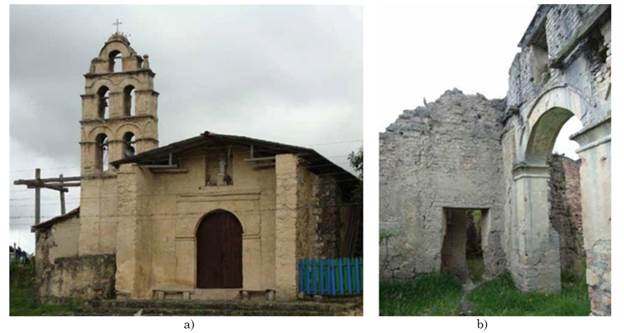
Source: Created by the authors.
Figure 1 Doctrinal chapel in Tausa: a) frontal sector; b) rear sector
In order to study the requirements for the maintenance of the chapel and restoration of the deteriorated sector, it was started laboratory research of the adobe materials of the chapel as well as local materials potentially useful for construction of new adobe structures. The study of the mechanical behavior of the adobe units and their changes due to ambient factors is an important step in understanding the functioning of the heritage buildings, especially in equatorial regions in which the effect of the solar activity is more aggressive. The cumulative effect of ambient conditions can be simulated in the laboratory by using accelerated weathering testers. The consequences of weathering in terms of changes in mechanical properties depend not only on the exposition period but also on the age of the adobe unit. Therefore, it is necessary to compare results between adobe units recovered from the chapel and recently compacted adobe units elaborated with soil obtained from a local deposit. The novelty of this study lies in its consideration of the temporal evolution of adobe properties. Large exposition periods to ambient conditions deteriorates the materials used in restoration. Initial mechanic properties of this material could exhibit good values for structural design but as time passes these properties could deteriorate, reducing the safety factor of the building. As a result, Deterioration Factors (DF) are proposed to be used as a first approximation for the quantification of the impact of the climatic conditions over the mechanical response of the adobe units across the time.
2. METHODOLOGICAL ASPECTS
2.1 Materials
The experimental program was carried out on two groups of materials. The first one corresponds to adobe samples recovered from the rear sector of the chapel (old adobe). 15 complete adobe units and 24 fragments (Figure 2) composed old adobe samples.
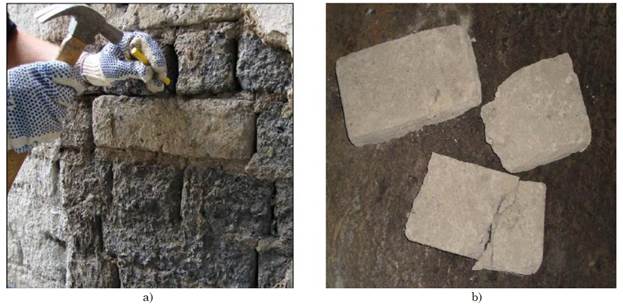
Source: Created by the authors
Figure 2 Samples of old adobe: a) recuperation of an adobe unit; b) recovered samples
The second group was obtained from a soil deposit located in the area close to the chapel (new adobe). Three soil deposits in the locality were preliminarily studied by performing soil classification tests and the most similar soil to the old adobe was the chosen one. Only results from the selected soil deposit are presented in this paper. With the new adobe, 60 samples were prepared by compaction in cylindrical molds under controlled water content. Then, they were extruded from the mold and left to air-drying with no action of direct sunlight for 45 days (Figure 3). Compaction of samples was carried out to simulate the methods employed by ancient construction workers in the production of adobe walls. For this reason, modern procedures such as Proctor compaction were avoided to preserve the authenticity of the compaction process. The moisture conditions for compaction were those necessary for better workability, mirroring the practices of traditional construction [32]. This procedure aimed to obtain samples with similar characteristics of adobe units made with this conventional technique.
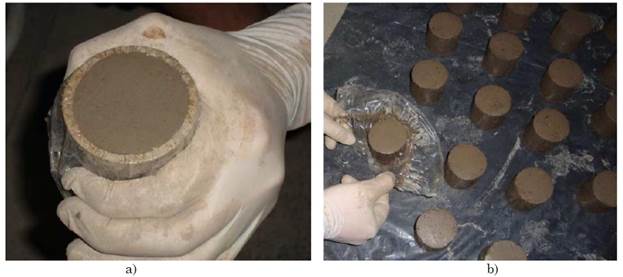
Source: Created by the authors
Figure 3 Samples of new adobe: a) preparation of the sample; b) air drying process
A comparison of the physical characteristics of old adobe and new adobe samples are presented in Table 1. Results from old adobe are like results previously obtained on samples of the same chapel by [32]. However, plasticity limits are slightly lower than the results found in the present work.
2.2 Equipment
Cylindrical samples from old adobe were obtained from adobe samples by using a core extractor. An accelerated weathering tester QUV-SE [33] simulates the effect of ambient exposition. Figure 4 illustrates the equipment with a group of samples ready to be exposed to weathering. The equipment is capable of controlling irradiance by a closed-loop control and uses eight UVA-340 lamps simulating the sunlight from 365nm down to the solar cut-off of 295 nm. In addition, the apparatus has a condensation mechanism to simulate outdoor moisture attack by heating a water reservoir to produce a vapor that maintains a 100 % relative humidity. Radiation and condensation alternate cyclically in programmable periods. Exposition of materials to this artificial regime produces degradation in a similar way that natural ambient conditions. Proportionally time factor between natural and artificial exposition is not constant since it depends on several variables that are not fully controlled (e.g., tested material, variation in natural conditions, variables capable of controlling in the equipment). The standard ASTM G154-16 [34] covers the principles and operating procedures for apparatuses designed for UV exposition of non-metallic materials.
Mechanical tests on the samples were done by using the GDS triaxial testing apparatus shown in Figure 5a [35]. The system allows controlling confinement pressure and vertical stress. A universal compression tester machine was used for unconfined compression tests on cylindrical samples (Figure 5b). Additional equipment and accessories include scale, oven, sieves, soil classification instruments and compaction molds.
2.3 Methodology
Eighteen samples of old adobe and eighteen samples of new adobe were subjected to accelerated weathering by mean of repeated stages of radiation and condensation: a cycle of six hours at controlled irradiance (1.60 W/m2) and temperature (45°C) followed by a condensation cycle (100 % relative humidity) of two hours long. This cyclic exposition to UV radiation followed by moisture is a variation to that used by [36]. The difference consisted in that the duration of each period was reduced given the effect of long condensation cycles on the consistency (checked by mean of a pocket penetrometer) of preliminary samples tested prior the final experimental program. The total accelerated weathering exposition varied in periods of 0, 360, 720, 1440, 2160, and 2880 hours. Eighteen additional samples of new adobe where exposed to ambient conditions at the same periods.
Once each exposure period was completed, three samples of each group (namely, old adobe subjected to accelerated weathering, new adobe subjected to accelerated weathering and new adobe subjected to natural weathering) were mechanically tested. Table 2 summarizes the total amount of samples exposed to weathering (accelerated or natural) for each period and adobe (old or new). Mechanical tests consisted of unconfined and unconsolidated undrained triaxial compression tests according to ASTM standards D2166 [37] and ASTM D2850-15 [38], respectively. It was fixed an axial velocity of 0.5 mm/min for both test methods whereas triaxial confinements were selected according to the approximated vertical pressure under 2 and 4m wall heights (40 and 80 kPa, respectively). In addition, the water content of samples after weathering was determined by using the standard method D2216-19 [39].
3. RESULTS AND DISCUSSION
A collection of data was obtained from the mechanical tests: compressive strength, shear strength parameters and shear moduli as a function of the weathering time. The time indicated in this section corresponds to the exposition time to accelerated weathering conditions (old adobe and new adobe) or the exposition time to natural conditions of new adobe measured after the initial 45 days of curing under air-drying.
3.1 Compressive strength
Results of compressive strength from unconfined and confined compression tests appear synthesized in Figure 6. The first characteristic is the difference between the compressive strength at null exposition time: for all the test points, new adobe samples exhibit higher strength than old adobe samples. For instance, the unconfined compressive strength of new adobe was almost twice than the same property for old adobe. The substantial difference between old and new adobe could be a result of long years of direct weathering and absence of maintenance that finally resulted in the ruined conditions in which the rear sector of the chapel was found. The second evident characteristic in Figure 6 is the almost constant behavior of the strength of old adobe along the exposition time. In other words, no further deterioration is observed by additional hours of accelerated ageing for a material that was already exposed to a prolonged time under neglecting conditions. Results of unconfined compressive strength of new adobe found in literature varies depending on the soil type, curing period, water content, among others. For instance, [40] report an unconfined compressive strength around 1.5 MPa for a sample after 28 days of natural curing and 3.5 % water content. In the present work, for similar conditions of natural curing and water content new adobe reaches 3.2 MPa, which is similar to the value reported by [32]. Reported data for unreinforced adobe units varies from 0.55 to 3.4 MPa [41]. Changes in water content have strong influence in the shear strength of adobe materials because the soil suction increases when the soil moisture reduces [27], [42].
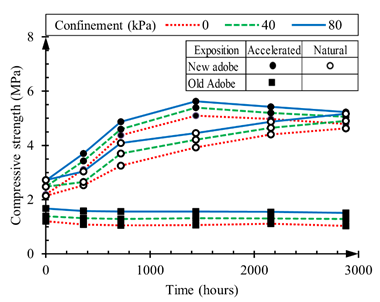
Source: Created by the authors
Figure 6 Unconfined and confined compressive strength of adobe samples
The natural-exposed new adobe gradually increases its strength, since during the period studied, the unconfined compressive strength raised from 2.2MPa up to 4.4 MPa with a rate of strengthening decreasing with time. On the other hand, artificially exposed new adobe showed an initial rapid increase in the strength, followed by a slight reduction of this property. By comparing natural and accelerated exposition curves from new adobe, naturally exposed curves could represent the first stages of accelerated curves, that is, 2880 hours under natural exposition could be reproduced by approximately 720 hours under artificial conditions. This ageing factor of four is approximated and only should be representative of the conditions in which the samples of this new adobe were subjected to ambient conditions. The effect of the confinement is reflected in the three set of samples: the higher the confinement stress, the greater the compressive strength is. Additional compressive strength caused by the applied confinement is practically constant irrespective of the adobe, weathering regime and exposition time.
3.2 Shear strength parameters
Stress states at failure from compression tests were represented by Mohr’s circles as can be shown in Figure 7, which includes the failure envelope according to the Mohr-Coulomb failure criterion given by (1). In this criterion, τ f is the shear stress at failure, c is cohesion, σ is the normal stress to the failure plane, and ϕ is the shear strength angle.
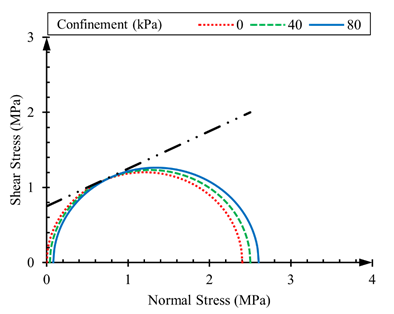
Source: Created by the authors
Figure 7 Mohr’s circles and failure envelope of new adobe and no exposition to weathering
Similar graphics for different adobes, exposition period and type of weathering were plotted and estimated the corresponding shear strength parameters, ϕ and c. Figure 8 presents the comparison of the different shear strength angles. It is evident that this parameter was not affected by the duration of the exposition, neither by natural nor by artificial regime. As a result of the acceleration in the weathering process, new adobe exposed to artificial conditions had a very little increment in the shear strength angle compared with the same adobe but naturally exposed. It is important to realize that old adobe retained the same shear strength angle despite the long and unfavorable conditions of natural weathering. From a practical point of view, the shear strength angle is 25° for old and new adobe, regardless the exposition conditions.
The patterns observed in the compressive strength analyzed in the preceding section, are reflected in the cohesion parameter (Figure 9). This observation indicates that the growth in the strength is primarily governed by an increase in the cementation of the clay minerals by cause of exposition to natural or artificial ageing. Old adobe is nearly insensitive to accelerated exposition because after approximately 300 years of natural exposition to weathering, almost 3000 hours of additional accelerated exposition are insignificant. Nevertheless, prolonged exposition to ambient conditions without preventive or reconstructive interventions seriously diminished the cohesion of adobe units. Reduction in cohesion values after 1500 hours of accelerated exposition evidenced in new adobe samples could be due to the same mechanism that occasioned the gradual reduction of cohesion in old adobe after many years from its construction until the present.
A more detailed investigation concerning the incidence of weathering conditions on the shear strength characteristics of the adobe should be addressed to develop a material constitutive model including deterioration features caused by ambient conditions. Research of this kind ought to include a detailed analysis of ambient conditions along historical periods in the specific site of the building under study and use accelerated weathering testers to simulate the ambient conditions on the materials, preferably imposing longer periods beyond that those used in this work. Resistance of adobe materials is presented in literature in terms of unconfined compressive strength [10] and there are no reports of shear-strength parameters.
3.3 Shear modulus
The initial slope of the curve shear stress against shear strain is suitable to estimate the shear modulus. Despite the deficiency in the resolution of the sensors regarding the small strain range in which the material is elastic, results presented in this section are useful for comparative purposes. Figure 10 compares the evolution of the shear moduli for the samples studied. As other results presented in previous sections, shear moduli from old adobe are not significantly affected by additional weathering.
Regarding new adobe, naturally exposed samples were stiffer than artificially exposed samples for all the periods of exposure to weathering. This fact could be due to the condensation cycles that allow more flexibility to the material as a consequence of the gain in moisture. New-adobe samples artificially exposed reached a kind of stabilization at the end of the weathering period imposed by the accelerated tester.
Comparing shear moduli of new adobe against old adobe, it is clear the significant difference along the entire period studied. Moreover, the ratio between new-adobe modulus and old-adobe modulus from samples artificially weathered is around two for all the exposition periods. The substantial reduction of the modulus observed in old-adobe samples could be caused by the careless conditions of the structure throughout the last century during which the walls were non-protected with a roof.
Reduction of the stiffness accelerates the degradation process of the structure because it increases the deformations under the constant load applied by the self-weight of the walls. In turn, additional deformations induce further stresses that could exceed the strength of the adobe and consequently causing failures, cracks, and detachments. The vicious circle completes given that the more material surface exposed to ambient factors, the fastest the degradation affect the surface of the material.
3.4 Deterioration Factor (DF)
Considering results show in Figures 6 to 10, Deterioration Factors (DF) can be proposed to consider them in vulnerability analysis of structures built of new adobes with typical degradation of the resistance properties. Inevitably, modification of the physical properties with the time will be occur, thus, the most rational decision is to quantify this diminution. Then if the compression strength is needed, a deterioration factor of 2 (DFcs=2) could be used. The deterioration factor is 1 for shear strength angle (DFϕ=1), the deterioration factor for the Shear Modulus is proposed as 2 (DFG=2) and the deterioration factor for the cohesion is 4 (DFC=4). Deterioration Factors (DF) are proposed to be used as a first approximation for the quantification of the impact of the climatic conditions over the mechanical response of the adobe units.
4. CONCLUSIONS
An experimental study concerning the influence of ambient conditions on the evolution of mechanical properties of adobe materials was carried out. An accelerated weathering machine was used to simulate the exposition of the materials to the main ambient factors that could deteriorate the mechanic properties.
A restoration project of the heritage buildings should include the analysis of the structural performance of the building as well as the study of materials that best fit with the characteristics of the existing materials. Old adobe recovered from the Tausa Chapel (Colombia) and new adobe obtained from a local soil deposit, are the two materials included in this research.
Ambient factors affect the compressive strength of adobe material. Initially, this property increases to a maximum value, after which, it gradually reduces until reaching values such as those found in the old adobe of the rear sector of the chapel. After many years of natural exposition to tropical ambient conditions, additional accelerated exposition does not modify the strength of the adobe.
Ageing of adobe affects the cohesion and the shear modulus while the shear strength angle remains practically intact whether in the old adobe or in the new adobe. However, more experimentation and analysis are required to propose a constitutive model that could reproduce the ambient effect on the mechanic behavior of adobe materials. Degradation of material properties by ambient factors accelerates the structural damage of the buildings, which in turn, increments the exposed surfaces to ambient effects. If it is necessary to consider the degradation of the mechanical properties across the time, Deterioration Factors (DF) are proposed to be used as a first approximation for the quantification of the impact of the climatic conditions over the mechanical response of the adobe units.
Preventive actions on adobe and rammed earth structures cut out the vicious circle of ambient exposition, mechanical degradation, and structural damage. In most of the cases, modest interventions like drainage control, maintenance of roofs or protective painting could be sufficient to reduce the negative impact of the ambient on the state of conservation of heritage constructions.














